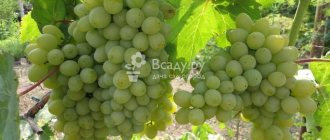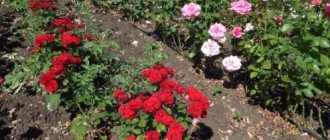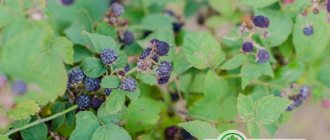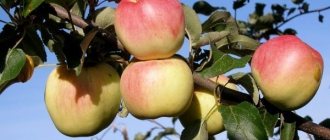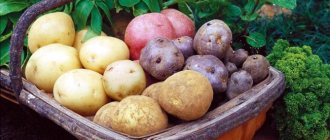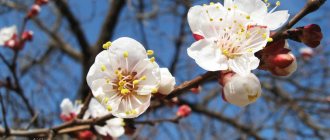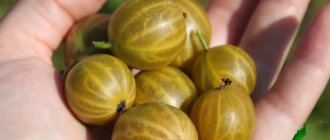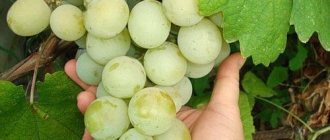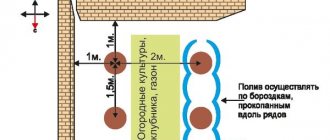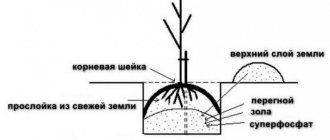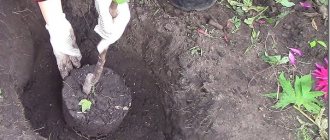Home Country garden
It would seem that all the most productive varieties of apple trees have long been studied by Russian gardeners, and each of them has chosen its place on the plot. But still, every year summer residents discover something new, and if the territory allows, they try to grow some new thing. What varieties of apple trees are best to plant in the Moscow region and central Russia to guarantee a high yield?
- 2 Which popular winter varieties of apple trees are best planted in the middle zone
- 3 The best autumn varieties of apple trees for the Moscow region and the middle zone (with photos)
- 4 The most productive autumn varieties of apple trees: description with photographs
- 5 What are the best varieties of autumn apple trees to plant in the Moscow region?
- 6 The best summer varieties of apple trees for the Moscow region and the middle zone
- 7 What other varieties of summer apple trees can be planted on the site
The best winter varieties of apple trees for the Moscow region and central Russia: photos and descriptions
The group of the best winter varieties of apple trees for the Moscow region and central Russia includes: Gray Anise, Antonovka vulgaris, Renet bergamot, Slavyanka, etc.
Winter variety Anise gray in the photo
Anise gray (striped)
The tree develops strongly, forming a powerful, wide-pyramidal, fairly dense crown. The main branches and their branches are firmly attached and can withstand large harvests. Restores the crown well. The most winter-hardy variety. Life expectancy is 60-80 years. There are also hundred-year-old trees.
This is one of the best winter varieties of apple trees for the Moscow region and the middle zone, high-yielding and early-fruiting. It begins to bear fruit from the 5th-6th year. Harvests are annual. During the period of initial fruiting, the yield is moderate, and at the time of full fruiting it produces high yields: 300-350 kg of apples are often harvested from individual trees. Flowering early.
As can be seen in the photo, this variety of apple trees, recommended for the Moscow region, has fruits of medium size, sometimes small (60-75 g), flat-round, slightly conical, with light green aromatic skin covered with a grayish-red smoky coating or numerous reddish stripes:
Apple variety “Anise gray” in the photo
“Anise” apple fruits are flat-round, slightly conical (photo)
The pulp is light green, juicy, sweet and sour with a spicy taste.
The fruits are harvested in the second half of September. They remain in storage until February.
Gray anise is the best variety of apple trees for fresh consumption and for technical processing (dough, jam, juices, confectionery); good for the lobe.
The main variety in all zones, both in rain-fed and irrigated gardens. Although it is drought-resistant, when irrigated, the size of the fruit and its yield increase sharply.
Apple tree "Antonovka vulgaris" in the photo
Antonovka vulgare
The tree reaches large sizes, forming a well-developed spherical crown with the main branches firmly attached to the trunk. Relatively frost-resistant. When describing this winter apple tree variety recommended for the Moscow region, it is worth noting that it grows and bears fruit better on moderately moist or irrigated soils.
It begins to bear fruit at the age of 7-8 years. Productivity is high, with a rapid increase during the period of initial fruiting. This necessitates systematic fertilization.
Look at the photo - when describing this winter variety of apple trees, it is especially worth noting the large (on average 120-150 g), round-cylindrical or conical with wide ribs, light yellow, with a strong aroma:
Winter apple tree variety “Antonovka vulgaris” in the photo
The fruits of the “Antonovka vulgaris” apple tree are round-cylindrical or conical with wide ribs (photo)
The pulp is white, juicy, tartrate-sweet, pleasant taste.
Flowering later. The fruits are harvested at the end of September. Ripening in October - November. Keeps in storage for 3-4 months, a valuable variety for fresh consumption and technical processing: large quantities are used for the preparation of marshmallows, candied fruits, marmalade, jelly, apple dough; good for the lobe.
Apple tree variety “Antonovka-kamenichka” in the photo
Fruit of the apple tree “Antonovka-kamenichka” in the photo
Antonovka-kamenichka
This winter variety of apple trees, recommended for the Moscow region, differs from Antonovka vulgaris in the smaller size of the fruits with a blush on them and a more compressed crown of the tree. Productivity is also good. Keeping quality - 4 -5 months.
Apple tree variety “Renet bergamot” in the photo
Fruit of the apple tree “Renet bergamot” in the photo
Renet bergamot
This winter variety of apple trees, grown in the middle zone, was obtained by I. V. Michurin from the seeds of Antonovka six hundred grams.
The tree is vigorous, with an oval, medium-dense crown, with strong main branches. In the conditions of the region it tolerates winter well. It begins to bear fruit at the age of 6-7 years. The productivity is high: in the conditions of the region it is no lower than that of gray anise. Flowering is mid-early.
It bears fruit mainly at the ends of fruit twigs, which must be taken into account when pruning.
Not resistant enough against scab, especially in rainy years or in low areas.
The fruits are large or medium (average weight 120-125 g), onion-shaped, without ribs. The stalk lacks the usual funnel, and some fruits have a tubercle here, like pears. When picked, the fruits are green, but when stored they acquire a yellow color, often with a pinkish “tan” on the sunny side. The pulp is dense, sweet and sour.
Late winter variety. The fruits are harvested at the end of September. The fruits last 6-7 months. They tolerate long-distance transportation well. Consumed fresh.
Here you can see photos of the best varieties of apple trees, the descriptions of which are given above:
Apple variety “Anise striped” in the photo
Apple variety “Antonovka ordinary” in the photo
Features of the region
The middle lane is a largely arbitrary concept. This is what is usually called the zone located in the center of the European part of our country. It includes Moscow, the Moscow region and adjacent regions (Smolensk, Tver, Yaroslavl, Vladimir, Ryazan, Tula, Kaluga, Oryol, Bryansk, Kostroma, Ivanovo, Nizhny Novgorod), as well as regions located to the north (Leningrad region and its immediate " neighbors"), southern Chernozem region and eastern Volga region. This vast territory is characterized by a temperate continental climate with relatively humid and warm weather in summer and not very severe frosts in winter.
Despite the presence of common features, the climate of specific areas located in the region varies quite a lot. Features such as altitude and the presence of nearby large waterways greatly influence the direction of prevailing winds, the amount of precipitation in summer and the depth of snow cover in winter.
In addition to climatic conditions, various factors influence the success of cultivation: soil composition, height of groundwater and many others.
When choosing seedlings for a summer residence, you need to pay attention to “local” conditions :
- The relief of the earth's surface at the location of the site. It is no secret that waste lands located in lowlands or wetlands are often given away to organize gardening partnerships. At such dachas in the spring and early summer, increased soil moisture is observed for a long time; the groundwater level remains high even in the hot summer. Tall apple trees with a taproot system do not grow and bear fruit well in areas of this type. In addition, the air temperature in winter in the lowlands is usually 2-3 degrees lower than in neighboring hills, which, during prolonged cold weather, can damage trees that are not particularly frost-resistant.
- Biological and soil characteristics of the site. The apple tree is not too capricious. It prefers soils with a slightly acidic or neutral reaction, but can grow in less comfortable conditions (especially if the soil is previously cultivated and its composition is further controlled). Trees grow best on loose and fertile soils: “chestnut”, sandy loam, chernozem, “taiga”, “gray”, etc. However, in areas located in the middle zone, clay and peat soils are not uncommon. For such places, it is necessary to choose the most unpretentious varieties or immediately give preference to compact plants, each of which must be planted on a separate, specially created “island” with more suitable nutritious soil.
The list of summer, autumn and winter varieties of apple trees for the middle zone is extremely extensive. In addition to plants recommended for cultivation throughout the region, there are also varieties adapted to specific, “local” conditions. Therefore, when choosing seedlings for your plot, you should take into account not only the general recommendations of scientists, but also the opinion of experienced gardeners living in the neighborhood.
What popular winter varieties of apple trees are best planted in the middle zone?
Apple tree variety “Slavyanka” in the photo
Fruit of the apple tree “Slavyanka” in the photo
Slav
This popular winter variety of apple trees for the middle zone was obtained by I. V. Michurin by crossing Antonovka vulgare with pineapple. The variety is early-bearing, high-yielding. It begins to bear fruit at 4-5 years of age with a rapid increase in yields over the years.
The tree is of moderate development, forms a rounded, medium-spreading beautiful crown. Winter hardiness is good. Flowering later.
The fruits are of medium or below average size (average weight 60-65 g), onion-round, yellowish-green when picked, turning yellow when stored. The pulp is juicy, tender, with excellent tartrate taste.
Fruit harvesting - at the end of September; consumer maturity - mid-November. They remain stored for 5-6 months; endure long-distance transport. The best dessert variety.
This is one of those varieties of apple trees that are best planted in the Moscow region on fertilized, moderately moist or irrigated soils. With a lack of moisture it produces small fruits.
Apple tree variety “Skryzhapel” in the photo
Fruits of the Skryzhapel apple tree in the photo
Skryzhapel
The tree is vigorous, with a pyramidal crown. Winter hardiness is good. It begins to bear fruit in the 5th-6th year. Productivity is high. Flowering occurs in medium terms.
At the age of initial fruiting it produces moderate yields, and at the age of full harvests it produces high yields.
The fruits are medium-sized, flat-rounded, strongly ribbed, yellow-green, with dark red densely spaced continuous and intermittent stripes.
This is one of the best varieties of apple trees for the middle zone with dense, juicy, light green pulp with a sweetish taste and slight acidity. The fruits are harvested at the end of September. Stored in storage for 6-7 months. Transport is tolerated well. They are often affected by scab.
The variety is found in several forms, differing in yield, fruit size and color. When propagating, it is necessary to take cuttings from trees that are more productive, with larger and better colored fruits.
Apple tree variety “Borsdorf-Chinese” in the photo
Fruits of the Borsdorf-Chinese apple tree in the photo
Borsdorf-Chinese
The variety was bred by I.V. Michurin by crossing Borsdorf bulbous with Chinese.
Trees of medium development. Winter hardiness is average. They begin to bear fruit at the age of 5-6 years with a rapid increase in yields over the years. Productivity is high: at 12 years of age it produces up to 130 kg per tree. The fruits are medium or below average size (average weight 60-70 g), rounded, smooth, greenish, yellow-green when lying down with whitish, barely noticeable subcutaneous dots, sometimes with blush on the sunny side. The pulp is dense, juicy, sweet and sour, with an excellent taste with a slight spice.
The fruits are harvested at the end of September. Consumer maturity in November - December. Stored in storage for up to 10 months. This is one of those varieties of apple trees that are best planted in the Moscow region; the fruits tolerate transportation well.
Higher yields and fruits of better commercial quality are obtained in irrigated gardens.
This selection contains photos of winter varieties of apple trees recommended for the Moscow region in central Russia:
Apple tree variety “Winter dessert” in the photo
Apple tree fruits “Winter dessert” in the photo
Winter dessert
The variety was bred by S.P. Kedrin in 1935 by crossing Antonovka saffron with Pepin London. The tree is winter-hardy, of medium vigor, with a flat-rounded crown. The variety is winter, its yield is high - in the 3rd year of fruiting the tree produced 21 kg of fruit.
The fruits are round-conical, medium in size, weighing about 100 g (larger than anises), covered with a bright speckled-striped blush along the main yellow color of the skin in the form of shiny carmine stripes and wide strokes with a strong bluish bloom.
The pulp is light yellow, juicy, fine-grained, dense, tender, with an excellent sweet and sour taste. Removable fruit maturity occurs in the first half of September. The shelf life and consumption period are longer than those of anise and anise (from October to March). Recommended for testing in all middle zones.
Apple tree variety “Yellow ribbed” in the photo
Fruit of the apple tree “Yellow ribbed” in the photo
Yellow ribbed
The variety was bred by S.P. Kedrin in 1935 by crossing Antonovka saffron with Pepin London. The tree is winter-hardy, medium-sized, with a rounded crown. The variety is typically winter. The annual yield is high. In the 3rd year of fruiting, the tree produces 19 kg of fruit.
The fruits are medium in size (larger than anises), conical in shape, with pronounced ribbing in the upper part of the fruit. The description of this variety of apple trees, recommended for the Moscow region, fully corresponds to the name: its fruits are yellow, with an orange-red tan on the sunny side.
The pulp is light yellow, juicy, dense, fine-grained, with an excellent sweet and sour taste. Removable maturity - in the second half of September. The fruits ripen in October - November and are stored for a long time without losing their high dessert qualities, having in this regard advantages over local varieties.
Next, you can familiarize yourself with the photo, name and description of apple tree varieties whose fruits ripen in the fall.
“Winter dessert” in the photo
“Yellow ribbed” in the photo
Varieties for intensive cultivation
Intensive cultivation of apple trees involves regularly harvesting large quantities of crops without losing the quality and quantity of the crop. Apple trees that are suitable for an intensive type of cultivation should bear fruit early, regularly and quickly produce their harvest. At the same time, there does not have to be a lot of harvest, because excessive ripening can lead to the tree producing fruit cyclically. It is important that the trees have all the listed qualities. These varieties are grown at an average pace, and are also necessarily shaped and pruned.
The best varieties for intensive cultivation are:
- Narodnoe is an early ripening variety with excellent taste;
- Melba is an apple variety with excellent taste.
The best autumn varieties of apple trees for the Moscow region and the middle zone (with photos)
Apple tree variety “Scarlet Anise” in the photo
Fruits of the apple tree “Scarlet Anise” in the photo
Scarlet anise (velvet, red, morocco)
An ancient variety, widespread in the middle zone.
The trees grow strongly, forming a wide pyramidal crown with dense branching. The main branches are firmly attached to the trunk and support large harvests. They are distinguished by durability, great frost resistance (but somewhat less than Gray Anise) and drought resistance. Productivity is high. During the period of initial fruiting (5-10 years) it produces moderate yields, during the period of highest yields (20-50 years) it produces high yields. Individual trees produce up to 200-300 kg of fruit. They begin to bear fruit from the 5th-6th year. Flowering early.
This autumn variety of apple trees for the middle zone has fruits of medium size (60-70 g), very beautiful, flat-rounded, slightly conical, with a blurred red blush and a bluish bloom, fragrant. The pulp is greenish-white, sometimes with a pink tint, dense, juicy. The taste is sweet and sour, spicy.
The fruits are harvested at the end of August - beginning of September. Stored in storage for 3-4 months. They tolerate long-distance transportation well. Consumed fresh; good for technical processing (jam, pastille, etc.) and lobes.
Fruits in storage are sometimes affected by bitter rot (pepper rot), so during storage they need to be checked more often. With high drought resistance, the variety in irrigated gardens produces higher yields of better commercial quality fruits.
Apple tree variety “Malt cross” in the photo
Fruits of the “Malt cross” apple tree in the photo
Malta cross
The trees are vigorous, with an elongated oval-rounded, medium-dense crown and straight main branches. In mature trees, under the weight of the harvest, the crown becomes spreading. The variety is winter-hardy. Productivity is high. It begins to bear fruit at 6-7 years of age. Flowering is mid-early. At the age of initial fruiting it produces moderate yields, and at the time of full fruiting it produces high yields, superior to many local varieties. Individual trees produce 250-350 kg of fruit.
This one of the best autumn varieties of apple trees for the Moscow region has large fruits (average weight 120 g), flat-rounded, slightly conical in the upper part, wide-ribbed.
The skin is yellow, matte, thick; on the sunny side it is covered with a continuous blush, along which there are red stripes. Large subcutaneous dots are scattered throughout the fruit, giving it a “marbling” appearance.
The pulp is yellowish-white, medium-dense, moderately juicy, with good sweet and sour taste.
The fruits are harvested at the end of August - beginning of September. They remain stored for 2-2.5 months. They tolerate transportation well. Consumed fresh and for technical processing. Good for the lobe.
Apple tree "Borovinka" in the photo
Borovinka
Central Russian variety, widespread in the middle zone.
Trees of medium development with a spherical, medium-dense crown, covered with dark green foliage. The main branches sometimes break off under the weight of the fruit. Therefore, by the time of full fruiting they should be secured by tying. The variety is winter-hardy. Productivity is high, annual. They begin to bear fruit in the 5th-6th year, sometimes earlier, with a rapid increase in yield. During the period of greatest harvests, 300-350 kg of fruits are often removed from individual trees. Flowering early. A good pollinator for many varieties.
Reacts well to fertilizers and irrigation.
In low-lying areas, as well as in rainy years, fruits are affected by scab.
Pay attention to the photo - this variety of apple trees, recommended for the Moscow region, has medium-sized or large fruits (average weight 80-100 g), round or flat-rounded, smooth or with weak ribbing:
Fruits of the Borovinka apple tree in the photo
The fruit is round or flat-round, smooth or with slight ribbing (photo)
The skin is yellow-green, smooth, shiny, covered with pale red or carmine wide stripes throughout the fruit. Subcutaneous points are clearly visible. The pulp is yellow-white, juicy, with a pleasant tartine-sweet taste.
Fruit harvesting is at the end of August. Consumed fresh and for technical processing. Transportation is well tolerated. Stored in storage for about 2 months.
Below you will find out what other varieties of autumn apple trees can be planted on your site.
Jonathan
Apple trees of this popular winter variety have many advantages. Fruiting occurs in the fifth year of cultivation. The plant has average winter hardiness and disease resistance.
Despite the fact that the plant was bred in America, in the central zone of our country it also bears fruit very abundantly. The apples are medium to large and have a yellowish-green color. Characterized by the presence of a dark red, pleasant blush. At the harvesting stage, fruits may have a “rusty” mesh. The strong and crispy flesh of the fruit is distinguished by its delicate creamy hue, juiciness and dessert taste.
The most productive autumn varieties of apple trees: description with photographs
Apple tree variety “White Skrut” in the photo
Fruits of the apple tree “White Skrut” in the photo
White skrut (pink skrut, Skrut, Semi-skrut)
The trees of this variety of autumn apple trees for the Moscow region are vigorous, durable, with a wide-spreading, medium-dense or sparse crown. The variety is highly winter-hardy and productive.
They begin to bear fruit at 6-7 years of age. Flowering is mid-early. At the age of initial and increasing fruiting (7 - 20 years) they produce moderate yields, and at the age of greatest yield they produce high yields, almost like Anise and Malta crusa.
The fruits are of medium size (average weight 75-100 g), flat-round or round, smooth, with a weak depression for the stalk, sometimes without it. The skin is snow-white, shiny, covered with faint pink stripes, strokes or solid washes. The pulp is white, juicy, sweet and sour, slightly astringent, mediocre taste. Fruits are often affected by scab and fruit rot.
The fruits are harvested at the end of August - beginning of September.
Consumed fresh and for technical processing (produces good quality dough); also suitable for lobes. It lasts for about one and a half months. Not suitable for long-distance transportation.
Apple tree variety "Antonovka six hundred gram" in the photo
Antonovka six hundred gram
The trees are powerfully developed, with an oval-round, medium-dense crown, covered with large leaves.
The variety is winter-hardy, the yield is high. Flowering later. At the age of 24-30 years, it produces an average of 100-150 kg of fruit per tree, and 300-500 kg are harvested from individual mature trees. Fruiting from 7-8 years.
The photo shows that this autumn variety of apple trees for the Moscow region has very large fruits (average weight 250-300 g), onion-oval, ribbed, yellowish-white:
Autumn variety “Antonovka six hundred grams” in the photo
The fruits are onion-oval, ribbed, yellowish-white (photo)
The pulp is juicy, white, fine-grained, tender. The taste is sweet and sour.
The fruits are harvested in mid-September. The fruits are consumed fresh and for technical processing. Not suitable for long-distance transportation. Stored in storage for about 2 months.
Apple tree variety "Bellefleur-Chinese" in the photo
Bellefleur-Chinese
The trees are vigorous, with an oval-rounded, medium-dense crown. Winter hardiness is average, yield is good. They begin to bear fruit at the age of 7-8.
During the period of initial and increasing fruiting, the yield is moderate, and during the period of full fruiting it is high. Flowering - in the middle period.
As you can see in the photo, this autumn variety of apple trees for the middle zone has large fruits (average weight 150 - 200 g), round, slightly ribbed:
Autumn variety “Bellefleur-Chinese” in the photo
The fruits are large, round, slightly ribbed in the photo
The skin is golden yellow, shiny, with bright red stripes. The pulp is white, juicy, fine-grained, tender, aromatic, with an excellent, slightly acidic and spicy taste.
The fruits are harvested in the first half of September. The fruits are stored until December. They tolerate transportation well. The best dessert variety.
Apple tree variety “Chinese Sanina” in the photo
Fruits of the “Chinese Sanina” apple tree in the photo
Chinese Sanina (Ranetka Sanina)
Volga region variety of large-fruited Chinese plant. Distributed throughout the middle zone.
The trees grow strongly, forming a fairly dense oval-rounded crown. Winter hardiness and productivity are high. Drought resistant. They begin to bear fruit from the 5th to 8th year (later than other Chinese). During the period of initial and increasing fruiting it produces moderate yields, and during the period of full fruiting it produces high yields.
The fruits are larger than many Chinese varieties (average weight 25-30 g), have an elongated oval or ovoid shape. The skin is green-yellow, covered almost over the entire surface with a blurred red blush. The pulp is dense, hard, sweet and sour taste.
The fruits are harvested at the end of August. Can last 2-2.5 months. They tolerate transportation well.
The fruits are used mainly for technical processing (confectionery, jam, juices, wine, etc.).
There are trees with a rounded, slightly spreading crown and a more pyramidal one. The former usually begin to bear fruit earlier and their yield is higher. When propagating a variety, cuttings must be taken from productive trees.
Look at the photos of apple tree varieties described above:
Apple tree variety “Bellefleur-Chinese” in the photo
Apple tree variety “Chinese Sanina” in the photo
Apple storage
The potential of a variety is not always realized.
- Keeping quality worsens after a season with too much or too little rain.
- Diseases (fruit rot, scab, etc.) make their own adjustments.
- In the northern regions there is not always enough heat, and this negatively affects the taste (apples do not have the promised sweetness).
Winter varieties of apple trees require a high level of agricultural technology.
Apples for winter storage are carefully picked from the tree, usually at the stage of technical (removable) ripeness. This occurs in September or October (depending on the variety, region and weather conditions). Consumer ripeness and biological maturity (full coloring of seeds and skin, fullness of taste) occur already in storage.
Medium-sized fruits, typical for this variety, last the longest.
- The apples are placed in boxes (preferably in one layer; if possible, each is wrapped in paper) and placed in a room with a temperature of +2 degrees and a humidity of 85%. This could be a cellar, underground floor, refrigerator, insulated shed, etc.
- Apples are also packaged in polyethylene (40–60 microns thick), but this method is not very good for Antonovka and its derivative varieties.
Violation of the temperature regime reduces shelf life. Temperature changes are especially harmful, leading to condensation and rotting of fruits from dampness. And with low humidity, apples dry out prematurely.
What are the best varieties of autumn apple trees to plant in the Moscow region?
Apple tree variety “Volzhskaya China” in the photo
Fruits of the “China Volga” apple tree in the photo
Chinese Volga No. 1 (Ranetka)
The most common variety in the middle zone is Kitayki, found in all gardens of the region.
The trees develop strongly, forming an oval-round, somewhat spreading crown. They are characterized by high winter hardiness and good annual yield. They begin to bear fruit at 3-4 years of age.
The fruits are medium-sized (for Chinese), round or oval, with a yellow skin covered almost over the entire surface with a blurred blush, with a non-falling calyx. The pulp is dense, juicy, with a sour taste. They are going for technical processing. Cold processing produces the best seeds for rootstocks.
This variety of autumn apple trees for the middle zone is the best representative of the group of Volga Chinese, similar to it in morphological and biological characteristics.
Apple tree variety “Russian Rosemary” in the photo
Fruits of the apple tree “Russian Rosemary” in the photo
Russian rosemary
The trees are highly developed, with a medium-dense oval-rounded crown. Winter hardiness is average. Productivity is good. Fruiting - from 6-7 years Flowering - in the middle period. Flowers are frost resistant
The fruits are large (average weight 120 -150 g), round or oval-round, smooth, light yellow, with a slight blush on the sunny side. The pulp is juicy, medium-dense, granular, with a weak aroma. The fruits of this one of the best varieties of apple trees for the Moscow region have a sweet and sour, slightly spicy taste.
The fruits are harvested in mid-September. They remain stored for 2-2.5 months. Transportation is handled well. The best dessert variety. Recommended for production testing.
Spartacus. The tree is vigorous with a wide pyramidal crown. Highly winter-hardy and productive: in the 3rd year of fruiting, 15 kg per tree was obtained. The fruits are large, reaching a weight of 200 g with an average weight of 110-120 g, round or flat-round in shape, blunt-ribbed. The color is yellowish, with a pink-red striped blush. The pulp is cream-colored, juicy, medium density, excellent sweet-sour taste, aromatic. The fruits are harvested in the first half of September. Late autumn variety. Zoned in all zones.
Apple tree variety "Zhigulevskoe" in the photo
Zhigulevskoe
The tree is vigorous, winter-hardy and more productive. The fruits are very large, average weight 150, the largest - 250 g, flat-round in shape.
Look at the photo - this is one of the best varieties of apple trees, the main color of the skin is bright golden-yellow, the outer skin is bright carmine-red, blurry striped, sharply outlined and stands out in relief from the main background:
The Zhigulevskoe apple tree is vigorous, winter-hardy and more productive (photo)
The color of the skin is bright golden yellow in the photo.
The pulp is creamy yellow, juicy, medium density, excellent sweet and sour taste. Harvesting maturity occurs in late August - early September, with a consumption period of September - November. Recommended for testing in all zones.
Apple tree variety “Kutuzovets” in the photo
Fruits of the Kutuzovets apple tree in the photo
Kutuzovets
Trees of medium vigor, with a rounded, medium-dense crown. Their winter hardiness is high. The variety is typically winter, productive, with a weakly expressed periodicity of fruiting. The main harvest is located mainly on ringlets. The yield of the mother tree in the second year of fruiting was 10 kg, and in the next 2-4 years - up to 20 kg.
Flowering occurs in the middle period and coincides with Gray Anise, Bergamot Renet and Borovinka. The flowers of this variety of apple trees for central Russia are relatively resistant to frost.
The fruits adhere firmly to the branches and are more resistant to scab and codling moths than Skryzhapel. They are also more resistant to putrefactive diseases both in the garden and during winter storage compared to other varieties. The fruits are of medium or above-average size, average weight 100-110 g, covered with a striped merging blush along the main yellow field, with numerous rather large subcutaneous dots, giving the fruits a kind of “marbling”.
The pulp is whitish, dense, juicy, fine-grained, sweet-sour, with a weakly expressed spice of excellent taste (higher than that of Skryzhapel). Fruit ripeness is at the end of September. They ripen well in storage in November - December, acquiring by this time their characteristic qualities. They can be kept in storage until spring.
Apple tree variety “Volga saffron” in the photo
Fruits of the apple tree “Volga saffron” in the photo
Volga saffron
Bred by S.P. Kedrin in 1935 by crossing Antonovka saffron with Pepin London. The tree is medium-sized. The winter hardiness of the variety is high, no lower than that of standard varieties - anise and Borovinka. Productivity is good, annual.
The fruits are medium-sized, with an average weight of about 100 g, and the largest one is about 130 g, flat-round, with noticeable ribbing and tubercles at the calyx, like those of calvilles. Their basic yellow color is blurred by a bright speckled-striped blush with prominent strokes, which gives them an attractive appearance. This is one of the best varieties of apple trees for central Russia with creamy-yellow, juicy, dense, not coarse pulp, sweet and sour, excellent taste.
The fruits are harvested in the first half of September. Keeping quality is longer than that of Antonovka and anise.
The following is a description of the varieties and photographs of apple tree varieties that bear fruit in the summer.
Promising varieties
Promising varieties are those that have as few flaws as possible. Often they do not suffer from pests or diseases, especially scab. And also promising varieties can adapt to changes in temperature and climate, withstand temporary drought, frost, bright sun and quickly recover from any damage.
Here are some of them:
- Farmel . Representatives of this variety are late ripening. The fruits are large, round, and regular in shape. They are aesthetically very attractive, with a beautiful blush on the sides, like porcelain. Their taste is very pleasant, sweet and sour. This variety is one that has absorbed all the best qualities - resistance to weather changes, early fruiting, and average tree size.
- Rossoshanskoye Augustovskoe . This is a summer representative of apples, which is one of the new ones, but is already gaining great popularity. The trees themselves are of medium size and height, with large leaves. The fruits are round, medium or large, juicy and medium juicy. Their taste indicator is perfectly sweet and sour. Fruits can be stored for no more than two months, and then only under proper temperature conditions.
- Glory to the winners . A versatile apple variety that can represent the best possible characteristics. The tree is large, tall with a spreading crown. The fruits even look appetizing, with a rich blush on a smooth green surface. The flesh is also very interesting, although it is soft and sweet, they have a curious sourness.
A promising apple tree.
The best summer varieties of apple trees for the Moscow region and the middle zone
Apple tree variety “Grushovka Moskovskaya” in the photo
Fruit of the apple tree “Grushovka Moskovskaya” in the photo
Moscow Grushovka (Skorospelka)
An ancient Russian variety, widespread everywhere.
The trees reach large sizes, form an elongated oval crown with strong and thick main branches of medium density, covered with long light green leaves. Frost resistance is high, productive and durable. The variety is early-bearing - begins to bear fruit from the 5th-6th year with a rapid increase in yield; at the age of full fruiting (20-50 years), harvests of 200-250 kg per tree per year are not uncommon. Flowering early.
The fruits are small, flat-conical, with thin shiny skin covered with pink-red stripes. The pulp of this one of the best summer varieties of apple trees for the middle zone is yellow-white, juicy, soft, with a pleasant sweet and sour taste. The fruits begin to ripen in early August. Their ripening is uneven.
Eat the fruits in 2-3 doses to avoid shedding.
Not suitable for long-distance transport. Can last 1-1.5 months. Consumption - fresh and for technical processing.
Apple tree variety “Pouring White” in the photo
Fruits of the apple tree “Pouring white” in the photo
Pouring white (Pudovshchina, Dolgostebelka)
The trees are of moderate height, forming a spherical, medium-dense crown with light green foliage. The variety is winter-hardy and productive, especially on strong soils. Severely affected by scab, especially in low places. It begins to bear fruit from the 5th-6th year. Flowering is mid-early.
The fruits of this summer variety of apple trees, recommended for the Moscow region, are of medium or below average size, round-conical in shape, light yellow. The pulp is white, fine-grained, sweet and sour taste. Ripen in the second half of August. The fruits last for about a month, but quickly deteriorate in taste. Transportation is not tolerated well. They are consumed fresh and can also be used for technical processing.
Apple tree variety “Alabaster” in the photo
Fruits of the “Alabaster” apple tree in the photo
Alabaster (Paper)
The spread is small. The trees are vigorous, with an oval-rounded crown, covered with light green leaves. Winter hardiness is average. It is more resistant to scab than Nalyva white. Productivity is good, almost annual. The variety is early fruiting, early summer. Bears fruit from 4-5 years. Blooms in mid-season.
The fruits are medium-sized (about 80 g), round-conical or oval, with wide ribs, on one of which there is a seam (the fold is the main distinguishing feature), light yellow, with a bloom and green subcutaneous dots. The pulp is white, juicy, with an excellent tartine-sweet taste.
The fruits are harvested in early August. Consumption: fresh. They last for about a month. This is one of those varieties of apple trees for the Moscow region that are recommended to be grown for quick consumption, since the fruits are not transportable. A good dessert variety.
Apple tree variety “Malt Bagaevsky” in the photo
Fruits of the apple tree “Malt Bagaevsky” in the photo
Malt bagayevsky
The trees are vigorous, with a wide-spreading, medium-dense crown. Their winter hardiness is good, not lower than Scarlet Anise and other winter-hardy varieties. It begins to bear fruit at the age of 6-7 years. The yield is high: during the period of full fruiting it produces an average of about 80 kg per tree, and from individual trees - 150-200 kg or more.
The fruits are medium in size, but larger than Scarlet Anise, flat-rounded, with white skin covered with a bright crimson-red blush and a light bloom, very beautiful.
The pulp is juicy, tender, white, with a good sweet and sour taste. Fruit ripening occurs in mid-August. They tolerate transportation well. They last for about 40 days. Consumed fresh.
Next, you will find out what other good varieties of apple trees are recommended for the middle zone and the Moscow region.
Below we describe what other varieties of apple trees are best to plant for the summer harvest.
general characteristics
In total there are more than 2000 varieties of apple trees. They differ in taste, fruit size, ripening time, which will determine their shelf life, resistance to temperature changes, and diseases. And also important conditions will be the size and dimensions of the tree itself. The central zone of the Russian Federation (including the Nizhny Novgorod region) is a territory with a temperate climate. This means that the variety must adapt well to frost and not be afraid of the baking sun.
According to the timing of ripening, all trees are divided into three types:
- Summer ones, which ripen in the second half of summer, but do not differ in their shelf life. They usually don't last for more than a month. They are very tasty when removed from the tree and are often used to make jams and compotes.
- Autumn ones, which can be stored for 3-4 months, their collection begins in August and ends in mid-autumn.
- Winter ones, which are stored almost all winter. They are collected from trees in September - November. During storage, they acquire all their taste qualities.
So, with the right selection of apple varieties, you can eat tasty, healthy fruits almost all year round.
What other varieties of summer apple trees can be planted on the site?
Apple tree variety “Chinese golden early” in the photo
Fruits of the “Chinese golden early” apple tree in the photo
Chinese golden early
Trees of medium development, with a pyramidal crown. They are characterized by high winter hardiness. The variety is early summer and early fruiting. You begin to bear fruit at 4-5 years of age. Productivity increases quickly. At the time of full fruiting it produces average or good yields. This summer variety of apple trees blooms early in the middle zone. The fruits are small (average weight 30-40 g), round, golden yellow. Often poured. The taste is sweet and pleasant.
The fruits are harvested at the end of July - beginning of August. They last 2-3 weeks. Consumed fresh and for technical processing.
Apple tree variety “Turnip Kopylova” in the photo
Fruits of the apple tree “Turnip Kopylova” in the photo
Turnip Kopylova (Red turnip). Trees of moderate growth, with long main branches forming a broom-shaped crown, spreading out in old age (they need supports). Winter hardiness is average. It is quite resistant to scab. It begins to bear fruit at the age of 5-6 years. Productivity is average or good, almost annual. Flowering early.
The fruits are medium-sized, onion-shaped, with a thick dark purple continuous blush and a bluish coating, through which blurry white subcutaneous dots are visible. The pulp is greenish-white, juicy, with a mediocre sweet-sour (fresh) taste.
The fruits are harvested in mid-August. They last for about 20 days. Not transportable. Consumed fresh.
Apple tree variety "Arkad sugar" in the photo
Arkad sugar (smoky)
Slightly widespread. The trees are vigorous, form an oval-rounded crown with strong main branches.
Resistant to frost. Productivity is average. It begins to bear fruit from the 6th to 7th year.
Look at the photo - this variety of apple trees for central Russia has fruits below average size, round-conical or round-cylindrical, yellow-green with an orange-reddish tan:
Fruits of the Arkad sugar apple tree in the photo
Fruits are round-conical or round-cylindrical in the photo
The pulp is whitish, loose, juicy, with a sweet honey taste.
Fruit harvesting occurs at the end of July - beginning of August; but the fruits become suitable for consumption long before ripening. Can be stored for about 3 weeks. Not transportable. Fresh consumption.
Apple tree variety “Daughter of Papirovka” in the photo
Fruits of the apple tree “Papirovka’s Daughter” in the photo
Daughter of Papirovka (Naliv Volzhsky)
The tree is medium-sized. Winter hardiness is no lower than that of local standard anise varieties, etc. Productivity is good, annual. The mother tree produces about 15 kg of fruit in the 3rd year of fruiting.
The fruits are of medium size, the size of Alabaster, with an average weight of about 80 g, round or flat-round in shape, weak wide ribbing, sometimes with a “seam”, like that of Alabaster. The color of the skin is greenish-yellow, with a golden tan and noticeable large subcutaneous dots.
The pulp is creamy, tender, juicy, sweet and sour, excellent taste. Ripening is in the first half of August. This is one of the best varieties of summer apple trees recommended for the Moscow region, resistant to scab.
- Author: admin
Rate this article:
- 5
- 4
- 3
- 2
- 1
(37 votes, average: 4.2 out of 5)
Share with your friends!
Comments (4)
Igor
05/11/2019 at 18:41 |
We have two winter apple trees in our garden - Semerenko and Jonathan. Semerenko - more shelf-stable and tasty apples, and Jonathan - very beautiful in appearance. I plan to plant another winter McIntosh apple tree.Answer
Yulia Expert Plodogorod
05/13/2019 at 23:02 |
Hello, Igor! You are absolutely right, the right variety is a significant component of success when harvesting apples and other fruits for the winter. I would like to note that correct preparation for storage is also very important.
This process needs to begin in early spring, when the garden needs to be treated for pests and diseases. After all, the more integral the apple is, the better it will lie. And vice versa, if the fruit has defects, for example from caterpillars, then they will not be stored for a long time. Next, it is advisable to pick the crop rather than wait for it to fall. Then the likelihood of mechanical injuries is lower, which also extends the shelf life. It is better to carry out the cleaning procedure in dry and windless weather. For tall trees, in addition to a ladder or stepladder, a fruit picker may be required. We do not recommend wiping the apples, otherwise you may leave them without their natural wax protection. If you had to collect them in wet weather, you should carefully blot them with a paper towel. It is important not to tear off the stalk. The room for storing fruit supplies for the winter should be dry and ventilated. Do not stack apples in piles, in several layers. It is best to lay them out in one layer. It is important to regularly check stocks, removing items that have begun to deteriorate. After all, because of them, those in close proximity can also disappear. When choosing an apple variety, you should pay attention to the plant’s requirements for soil, lighting and other parameters. We recommend, if possible, choosing those varieties that best suit the conditions of the site. Then care will be easier, and there is less chance that the plant will not develop normally.
Answer
Anton
03/18/2020 at 14:30 |
Unfortunately, in the middle zone only apples that cannot be stored for a long time grow well. Late varieties of apple trees bear fruit worse and are more demanding on growing conditions.
Answer
Yulia Expert Plodogorod
03/19/2020 at 01:29 |
Hello, Anton! Sometimes difficulties in growing certain varieties of apple trees are associated not only with climate, but also with specific cultivation and care conditions. The fruits may not ripen due to the wrong location for the seedling. If you plant such a tree in dense shade, close to other large crops, in a draft and cold wind, there may not be a good harvest.
When the apple tree is young, it is better to normalize the harvest by removing some of the fruit at all stages of ripening. If a plant with a weak root system is overloaded with the harvest, this will cause slow development and the fruit will not ripen on time, and their quality and taste may deteriorate.
Planting a plant on poor soil is also fraught with poor harvests. During the planting process, we recommend adding organic matter and complex mineral fertilizers to the planting hole. In the future, regular feeding is also necessary.
If the groundwater in the area is located close to the surface, this can be another reason for the poor development of fruit trees.
Freezing in winter also significantly affects the formation of fruits in the next season. We recommend thoroughly mulching the soil under apple trees and covering the root collar in winter. For young seedlings, wrapping the above-ground parts may also be necessary.
Answer
Bogatyr
This is a winter variety of apples for the Urals and other regions of Russia - it is grown throughout the country. It was introduced back in 1925, and during that time it established itself well. The tree is powerful, reaching a height of 5 meters. The crown is spreading and can reach a diameter of 6 meters.
The crop produces large apples, some of them weigh 300 grams, although the average weight does not exceed 200 grams. They are round, wide at the base, with green skin and yellow spots. During storage, the tint may turn yellow. The pulp is distinguished by its high density and pleasant aroma, and it is also crispy. The taste is sweet and sour. The fruits contain quite a lot of ascorbic acid. It is worth noting that Bogatyr needs pollinators for a normal harvest.
An adult produces up to 100 kilograms of fruit. The average figure reaches 80 kilograms. Bogatyr is considered one of the most delicious winter apple varieties due to its high tasting scores. It is recommended to collect fruits at least in October, otherwise they will be of poor quality. In addition, such an error will negatively affect keeping quality.
The variety has very high winter hardiness, which is why gardeners love it so much. As the tree matures, it adapts well to environmental conditions and even the most severe frosts. However, seedlings should be mulched in the root zone.
Bogatyr is also pleased with its high immunity to scab, which poses a great danger to the tree. Thanks to this, caring for it is not a problem, which is also indicated in the reviews of summer residents. They emphasize that it is enough to carry out timely pruning and watering. You can make juices and compotes from apples, although they are very good fresh.
Star
The Zvezdochka variety appeared more than 50 years ago, but is still popular today. The fruits are ideal for consumption in winter; many people associate them with the New Year. The trees grow quite powerful; they have a round crown, which becomes spreading during fruiting. Ovaries usually appear on twigs and spears, and occasionally on young ringlets.
Precociousness is assessed by experts as moderate. It will take about 5 years to wait for the harvest after planting the plant. At the same time, fruits are formed every year, but in moderate quantities. Some summer residents say that Zvezdochka is similar to the Bogatyr variety.
The fruits are moderate in size. Their weight usually does not exceed 100 grams, but sometimes it is slightly higher. The shape is a flat circle, there are barely noticeable ribs. There is a pronounced waxy coating. The skin color is light green with a dark red blush. The pulp is juicy and pleasant in texture, has a sweet and sour taste.
When to harvest the winter apple variety Zvezdochka? It is best to do this at the end of September or mid-October. The fruits remain in good condition until spring.
The following positive features of Zvezdochka are highlighted: resistance to various diseases, the ability to quickly regenerate after freezing, sustainable yield, high quality fruit, long shelf life and portability of transportation.
Disadvantages - not the best resistance to winter, not the best early fruiting, reduction of apples in mature trees (this can be avoided with the help of formative and rejuvenating prunings). Also, pollinating varieties should be planted next to the crop.
Gardeners claim that due to its moderate winter hardiness, the plant needs to be carefully covered before the onset of the cold season. If you prepare it correctly, it will go away faster after bad weather. It is recommended to generally tilt young individuals towards the ground and cover them, and when snow falls, form a snowdrift.
